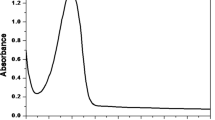Abstract
Trapping activity of new hydroxy derivatives of chalcones toward electrochemically generated superoxide anion radical (\({\text{O}}_{2}^{{\bullet \, - }}\)) in a xanthine/xanthine oxidase enzymatic system upon reduction of nitro blue tetrazolium and during non-enzymatic quinoid oxidation of adrenaline in alkaline medium has been studied. Antiradical activity of new hydroxy derivatives of chalcones toward \({\text{O}}_{2}^{{\bullet \, - }}\) has been established for the first time. Reaction with electrochemically generated \({\text{O}}_{2}^{{\bullet \, - }}\) and higher antiradical activity under adrenaline autooxidation conditions in alkaline medium has been revealed for chalcone containing 2,6-di-tert-butylphenol fragment. Chalcone with two non-shielded OH groups showed the highest trapping activity in xanthine/xanthine oxidase enzymatic system and SOD-protective activity. The inhibiting activity of hydroxy derivatives of chalcones toward \({\text{O}}_{2}^{{\bullet \, - }}\) agrees well with in silico prediction and indicates their ability to decrease probability of oxidative stress development. Correlation has been found between the ability of the studied chalcones to consume superoxide anion radical and inhibiting activity in model systems of peroxide oxidation of oleic acid and tilapia liver lipids.



Similar content being viewed by others
REFERENCES
Lambeth, J.D., Free Radic. Biol. Med., 2007, vol. 43, pp. 332–347. https://doi.org/10.1016/j.freeradbiomed.2007.03.027
Zabik, N.L., Anwar, S., Ziu, I., and Martic-Milne, S., Electrochim. Acta, 2019, vol. 296, no. 10, pp. 174–180. https://doi.org/10.1016/j.electacta.2018.11.051
Phaniendra, A., Jestadi, D.B., and Periyasamy, L., Ind. J. Clin. Biochem., 2015, vol. 30, no. 1, pp. 11–26. https://doi.org/10.1007/s12291-014-0446-0
Hayyan, M., Hashim, M.A., and Al Nashef, I.M., Chem. Rev., 2016, vol. 116, no. 5, pp. 3029–3085. https://doi.org/10.1021/acs.chemrev.5b00407
Adelusi, T.I., Akinbolaji, G.R., Yin, X., Ayinde, K.S., and Olaoba, O.T., Eur. J. Pharmacol., 2021, vol. 891, no. 15, p. 173695. https://doi.org/10.1016/j.ejphar.2020.173695
Janković, T., Turković, N., Kotur-Stevuljević, J., Vujićd, Z., and Ivković, B., Chem.-Biol. Interact., 2020, vol. 324, p. 109084. https://doi.org/10.1016/j.cbi.2020.109084
Zengin, G., Aktumsek, A., Guler, G.O., Cakmak, Y.S., and Yildiztugay, E., Rec. Nat. Prod., 2011, vol. 5, pp. 123–132.
Zhao, Zh., Cui, X., Ma, X., and Wang, Z., Acta Biochim. Biophys. Sin., 2020, vol. 52, no. 11, pp. 1265–1273. https://doi.org/10.1093/abbs/gmaa124
Prochazkova, D., Bousova, I., and Wilhelmova, N., Fitoterapia, 2011, vol. 82, no. 4, pp. 513–523. https://doi.org/10.1093/abbs/gmaa124
Osipova, V.P., Polovinkina, M.A., Telekova, L.R., Velikorodov, A.V., Stepkina, N.N., and Berberova, N.T., Russ. Chem. Bull., 2020, vol. 69, no. 3, pp. 504–509. https://doi.org/10.1007/s11172-020-2790-y
Magalhães, L.M., Segundo, M.A., Reis, S., and Lima, J., Anal. Chim. Acta, 2008, vol. 613, no. 1, pp. 1–19. https://doi.org/10.1016/j.aca.2008.02.047
Osipova, V., Polovinkina, M., Osipova, A., Gracheva, Yu., and Okhlobystin, A., Turk. J. Chem., 2019, vol. 43, pp. 1336–1349. https://doi.org/10.3906/kim-1904-40
Zagrean-Tuza, C., Dorneanu, S., and Mot, A.C., Free Radical Biol. Med., 2020, vol. 146, pp. 189–197. https://doi.org/10.1016/j.freeradbiomed.2019.11.006
Polovinkina, M.A., Kolyada, M.N., Osipova, V.P., Berberova, N.T., Chukicheva, I.Y., Shumova, O.A., and Kutchin, A.V., Dokl. Chem., 2019, vol. 484, no. 5, pp. 568–571. https://doi.org/10.31857/S0869-56524845568-571
Funding
This work was financially supported by the Russian Foundation for Basic Research (project no. 19-03-00006а, electrochemical studies, NBT test, adrenaline autooxidation) and by the State Assignment no. 01201354245 (SOD-protective activity of biopreparation).
Author information
Authors and Affiliations
Corresponding author
Ethics declarations
The authors declare no conflicts of interest.
Additional information
Translated by I. Kudryavtsev
Rights and permissions
About this article
Cite this article
Polovinkina, M.A., Osipova, V.P., Osipova, A.D. et al. Activity of Hydroxy Derivatives of Chalcones toward Superoxide Anion Radical. Dokl Chem 500, 184–187 (2021). https://doi.org/10.1134/S0012500821090032
Received:
Revised:
Accepted:
Published:
Issue Date:
DOI: https://doi.org/10.1134/S0012500821090032




